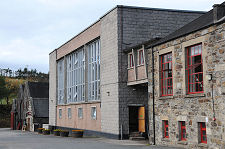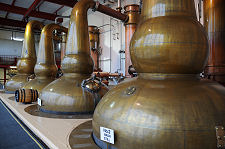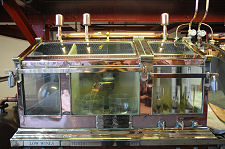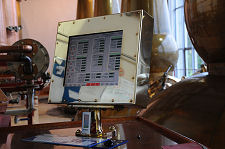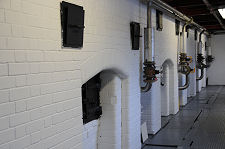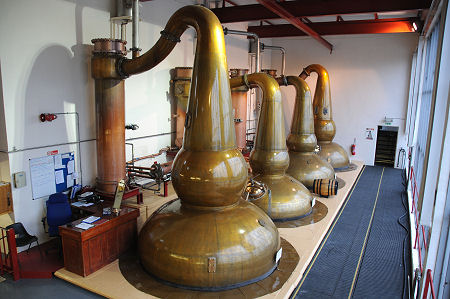 The Still House at Glendronach |
Glendronach Distillery stands in the glen of the Dronach Burn, amid the fertile rolling countryside of Aberdeenshire. It located about five miles south of Aberchirder and six miles north-east of Huntly. If approaching along the B9001 from the A97 between those two settlements the distillery suddenly comes into view in the glen below you, partly hidden among trees.
As you drive into the distillery you are struck by the contrast between the traditional stone buildings which form much of it, and the glass fronted still house which stands at the heart of the complex. The still house and, presumably, the chimney beside it, were added in 1966 when the number of stills was increased from two to four. The old and the new have had some time to settle down together and the overall effect is reasonably harmonious.
The second thing you notice about the distillery, even before you get out of your car, is just how exceptionally well cared for it is. All the external paintwork is in a tasteful shade of red, and it all appears very fresh. Meanwhile the surrounding grounds are nicely landscaped, and there are planters (made from cut down whisky barrels) with flowers in strategic locations. At this point the observant might also notice that all the external doors and gateways in the distillery are (or can be) covered with solid metal floodgates. The Dronach Burn has carved itself out a beautiful little glen, but it can be an unpredictable and destructive neighbour at times.
The attractive visitor centre at Glendronach Distillery opened in 2010. The main door is down the side of the building, and within the centre you find a reception and shop, a sampling room that includes an area in which visitors can fill their own bottle of Glendronach, and a window that allows visitors to view the bonded warehouse next door. There is also an area where those about to tour the distillery are given an AV presentation.
Glendronach Distillery was founded in 1826 by James Allardice, the local laird and resident of the neighbouring Glen House, a fine house built in 1771 now used for corporate entertainment. This was only three years after distilleries had been legalised, and having produced the first batch of whisky under his new licence (after, it seems, many years of producing illicit whisky on the same site), James Allardice set off to Edinburgh to try to sell it. He found this more difficult than expected and many inns claimed to be stocked up for the season ahead and unwilling to try a new supplier.
En route back to his hotel James was stopped by two of Edinburgh's young ladies of the night who wanted him to buy them a drink. Instead he took them back to his inn room to drink his own "Guid GlenDronach". The following morning the ladies returned to his hotel, doubtless to the dismay of the staff, to ask for more Glendronach to share with their friends. Within a very short time Glendronach was the tipple of choice for a certain segment of the market in Edinburgh, and innkeepers had to respond to being asked for it by name. By the time James Allardice headed north from Edinburgh, he had arranged to supply Glendronach whisky to most of the many public houses and inns along the Royal Mile.
The distillery was purchased in 1830 by Walter Scott, owner of the Teaninich Distillery, and by the 1860s it paid more duty than any other distillery in the Highlands. In 1920 Glendronach was purchased by Captain Charles Grant, the son of the founder of Glenfiddich Distillery. The Grant family sold Glendronach to William Teacher & Sons in 1960. They built the new still house to increase capacity in 1966, and ten years later ownership passed to Allied Distillers.
Glendronach was mothballed in 1996, but resumed production in 2002. The floor maltings which had still been operational in 1996 did not reopen with the rest of the distillery, though the buildings and equipment remain. Glendronach was one of the last distilleries in Scotland to use coal fires to heat the stills, but they were converted to use indirect steam heat in 2005, the same year that the distillery was taken over by Chivas Brothers. In 2008 the distillery was purchased by the BenRiach Distillery Company Ltd., who have since invested heavily in improving production and facilities (for example establishing the visitor centre). It is great to see an important distillery back in independent ownership, and this latest development certainly bodes well for the future.
From a visitor's perspective, the story of Glendronach has two significant consequences. The first is that though not all the areas are currently operational, it is possible to visit what could easily be restored to use as a fully functional floor maltings (and, who knows, with the new ownership might one day become so). As a result you can see the malt floors and the kiln which are both now absent from all but a handful of distilleries.
The second fact that imposes itself on visitors is the immense pride that everyone associated with the distillery takes in it. We've talked already about the outstanding presentation of the exterior: and this is carried through to the production areas of the distillery. Every metal surface is superbly polished: the copper top of the underback standing next to the mash tun has a mirror-like finish, as have many of the pipes in the still house, and the spirit safe is a work of art. But perhaps the most telling indication of the lengths that have been gone to to get every detail perfect can be found in the form of the brass casing around the computer screen in the still house. This is gloriously unnecessary, yet was done because "it looked right". The aura of cleanliness even extends to the old coal fired furnaces that remain in place beneath the stills: though now painted white and simply a means of routing the steam pipes to the stills.
Meanwhile, of course, you also get to see and enjoy the more usual elements found in a distillery tour. The malt mill comes in typical Porteus red, but turns out to have been manufactured by Robert Boby Ltd of Bury St Edmunds. The mash tun has a wonderful domed copper lid and an unusual mesh cover over the viewing hatch. A doorway behind the mash tun leads through to the washbacks, while stairs lead up to a covered walkway into the still house. The glass front of the building means that the four stills, arranged in two pairs, are well illuminated, as are the condensers on the wall behind them. You can find out more about Making Malt Whisky from our series of feature pages showing the stages in the process.
As already noted, one of the bonded warehouses can be viewed from within the visitor centre. Glendronach was traditionally best known for whisky matured in sherry casks, though bourbon casks were increasingly used after the resumption of production in 2002, and especially after the change of ownership in 2005. One of the many changes introduced by the BenRiach Distillery Company Ltd. since 2008 has been to return to the use of sherry casks, which in turn suggests a return to Glendronach's roots as a highly rated whisky with its own distinct character.
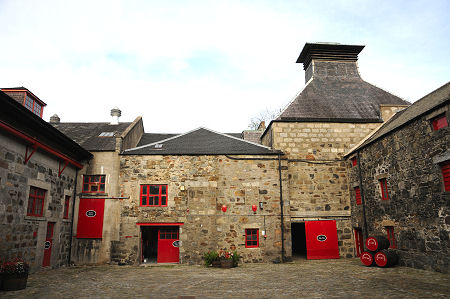 Older Part of the Distillery |

|
|
|
Visitor InformationView Location on MapForgue, By Huntly, AB54 6DB. Tel: 01466 730202. info@ glendronachdistillery.co.uk Grid Ref: NJ 626 439 www.glendronachdistillery.com Opening Hours Tours & Admission What3Words Location: ///sand.importing.baked |
 Older Distillery Buildings |
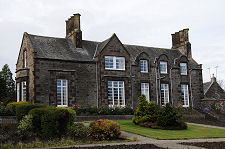 Glen House |
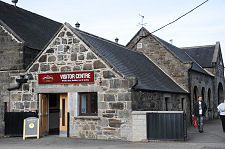 Visitor Centre Visitor Centre |
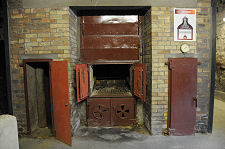 The Kiln The Kiln |
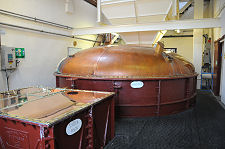 The Mash Tun and the Under
Back The Mash Tun and the Under
Back |
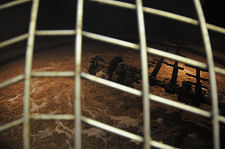 Inside the Mash Tun Inside the Mash Tun |
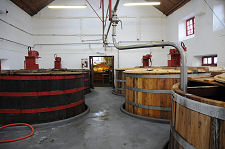 The Washbacks The Washbacks |
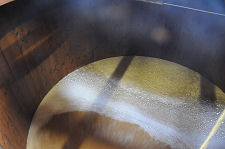 Inside a Washback Inside a Washback |
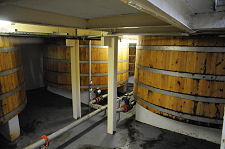 Bottoms of the
Washbacks Bottoms of the
Washbacks |
